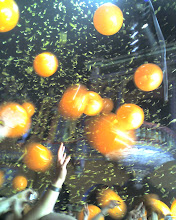Thursday, February 4, 2010
Type 4 | Paragraph
Type in the environment has been around for a long time. Every since the days of the early shop sings, there has been a need for words and letters outside the printed page. And while this was mostly the sole purpose for environmental typography, it wasn’t until the late 1800s that posters started appearing. With them they brought a revolution in typography, as well as an appreciation for display lettering. Nowadays, environmental type is used in anything from the practical (things like street signs or house numbers), to posters, flyers, and billboards. The span of environmental type is vast. However, it is noticeable that outside the practical tendencies of environmental type, there are few applications. One such example is graffiti. Graffiti is expressive typography, as well as art. But it is hardly design, and usually the spray paint is a heavy pollutant. How can one use the environment to achieve an artistic goal without intruding and polluting their surroundings? One such person to have success is Andy Goldsworthy, who only used found objects in the environment for his art. He used ice, sand, stone, leaves, branches, and many other objects to create very interesting sculptures. These sculptures would eventually dissipate, destroyed by natural causes. They were ephemeral in nature. However, it is easier to create art in the environment, because it is often made for beauty, without any practical reason. It is important to recognize the need of reduced pollution in the design process. Using found objects in the environment is the best way to do so. The hard part is making such typography practical. Therein lies the question: How can found objects in the environment be used for purposeful design?
Subscribe to:
Post Comments (Atom)


No comments:
Post a Comment